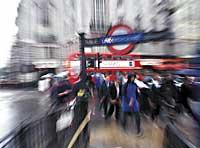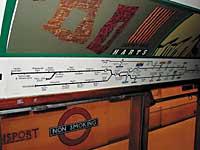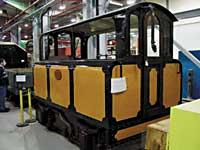Underground traffic

Metropolitan railway was the first underground railway service in the world in London on 9 January 1863. It was the birth of the metro. At that time London was the largest city in the world, with more than two million inhabitants and with a great expansion. No wonder the port of London was the most important of the time. Every day all kinds of ships loaded with goods entered and left their platforms.
Of course, the port movement also had its reflection in the city, as the streets of the city were filled with vehicles and people who had to move to the port. Not only that. As it was a rich and industrial city, the urban movement was large, and the number of people and vehicles arriving in the city inside the island was not small. In this confusion, traffic problems became everyday. The creation of the metro was the solution chosen by the authorities.
The decision was revolutionary, but the metro had a hard time becoming a real solution to traffic problems. In fact, steam engines were used for train traction. It is not enough to walk underground, and to move I had to use a system that produced a lot of smoke!
However, the new means of transport had a notable impact on London's land traffic, which achieved remarkable relief. Therefore, in other growing cities they bet on the metro. The second metro in the world opened in New York in 1868.

Royal impulse of metropolitan trains XIX. It came at the end of the 20th century. In 1890 the first electric traction line was launched in London. The results were very satisfactory, so they created the metro service in most major cities in the world: Istanbul in 1896, Paris in 1900, Boston in 1901, Berlin in 1902... Even in the meters that previously circulated through the steam engine, electricity was soon used.
The speed of electricity is not, but things have changed quickly in the meters. From the beginning of the century to the present. As in other areas, technological progress has been hugely reflected in underground rail services. The current meters are fast, comfortable and safe, and have all the means offered by the technology: information screens, oral and written messages, heating and cooling systems, automatic driving systems... but the transport system itself has not changed too much.
Most meters have two tracks, each in one direction. They have another electricity collection lane on the sides or sometimes the catenary on the top. Hence the energy they need to move. Although the width of the railway is common, the wagons are usually narrower and lower than normal. And the platforms of the stations are usually high to be able to comfortably access the wagons and gain time.
The length of the trains depends on the length of the stops. For example, some New York subway lines include 11-car trains. In Paris it is usual to have 5 cars and in Madrid between 3 and 6 according to line. Sometimes all the cars that make up the train are machine, pull, others are towed. In any case, all the motor cars of the trains move as if they were one, since it is usually a driver with control. This driver usually goes on the front of the train.
A few years ago the work of the driver was to drive the train, but today, thanks to the contributions of technology, has other functions. Since most metro lines are automatic, the service is very regular and from the point of view energy saving is cheaper. Drivers must monitor the passenger entrances and exits, check that the doors are opened and closed correctly, that the train is working properly and that there are no errors in the automatic driving system. Even when automatic systems fail, drivers can take control of the train.

However, the control of the train is not limited to what the driver observes or to what the safety systems inside the train indicate. In the current metros, rail traffic is channeled through centralized command points. They monitor each line and send orders to the automatic systems: in a specific stop location, in a rejection station, in case it is necessary to accelerate, etc., they have the possibility of interrupting the light force or giving direct orders to the drivers through different transmission systems.
These characteristics make the metro the most used means of transport in large cities. Although data vary greatly depending on the frequency and length of trains, experts say that between 30,000 and 40,000 passengers per hour use the metro. Throughout the day there are many people. Take 8 a.m. to 8 p.m. 12 hours. During this time, in any city in the world more than 700,000 people move by metro.
The data is impressive, but the meters have not been able to solve traffic problems in large cities. To relieve itself, that cannot be denied.
Buletina
Bidali zure helbide elektronikoa eta jaso asteroko buletina zure sarrera-ontzian











